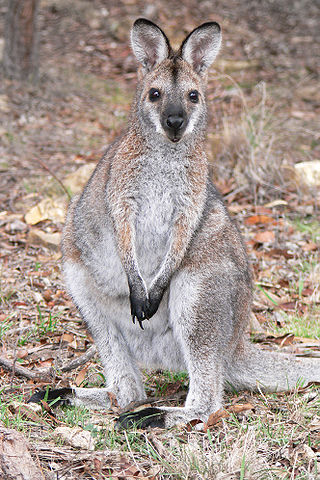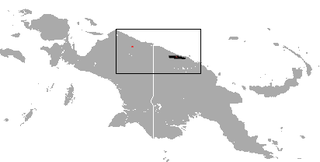
Obdurodon is a genus of extinct platypus-like Australian monotreme which lived from the Late Oligocene to the Late Miocene. Three species have been described in the genus, the type species Obdurodon insignis, plus Obdurodon dicksoni and Obdurodon tharalkooschild. The species appeared much like their modern day relative the platypus, except adults retained their molar teeth, and unlike the platypus, which forages on the lakebed, they may have foraged in the water column or surface.

Macropodidae is a family of marsupials that includes kangaroos, wallabies, tree-kangaroos, wallaroos, pademelons, quokkas, and several other groups. These genera are allied to the suborder Macropodiformes, containing other macropods, and are native to the Australian continent, New Guinea and nearby islands.

The order Peramelemorphia includes the bandicoots and bilbies. All members of the order are endemic to Australia-New Guinea and most have the characteristic bandicoot shape: a plump, arch-backed body with a long, delicately tapering snout, very large upright ears, relatively long, thin legs, and a thin tail. Their size varies from about 140 grams up to 4 kilograms, but most species are about one kilogram.

Kollikodon is an extinct species of mammal, considered to be an early monotreme. It is known only from an opalised dentary fragment, with one premolar and two molars in situ, as well as a referred maxillary fragment containing the last premolar and all four molars. The fossils were found in the Griman Creek Formation at Lightning Ridge, New South Wales, Australia, as was Steropodon. Kollikodon lived in the Late Cretaceous period, during the Cenomanian age.

The dingiso, also known as the bondegezou or bakaga, is an endangered, long-tailed marsupial found only in mountain forests on the west of the island of New Guinea. It is a species of tree-kangaroo, which are mammals native to Australia and New Guinea that feed on leaves or other plant matter. It belongs to the macropodid family (Macropodidae) with kangaroos, and carries its young in a pouch like most other marsupials. Though sacred to the local Moni people, it is still threatened by hunting and habitat loss.

Paranthropus aethiopicus is an extinct species of robust australopithecine from the Late Pliocene to Early Pleistocene of East Africa about 2.7–2.3 million years ago. However, it is much debated whether or not Paranthropus is an invalid grouping and is synonymous with Australopithecus, so the species is also often classified as Australopithecus aethiopicus. Whatever the case, it is considered to have been the ancestor of the much more robust P. boisei. It is debated if P. aethiopicus should be subsumed under P. boisei, and the terms P. boisei sensu lato and P. boisei sensu stricto can be used to respectively include and exclude P. aethiopicus from P. boisei.

The golden-mantled tree-kangaroo is a critically endangered, furry, bear-like mammal found only in mountain rain forests on the island of New Guinea. Like other tree-kangaroos, it lives in trees and feeds on plant matter. It belongs to the macropod family (Macropodidae) with kangaroos, and carries its young in a pouch like other marsupials. The range is restricted to two small mountain areas in the north and it is threatened by hunting and habitat loss.

Protemnodon is an extinct genus of megafaunal macropodids that existed in Australia, Tasmania, and New Guinea in the Pliocene and Pleistocene. Members of this genus are also called giant kangaroos.

A cusp is a pointed, projecting, or elevated feature. In animals, it is usually used to refer to raised points on the crowns of teeth. The concept is also used with regard to the leaflets of the four heart valves. The mitral valve, which has two cusps, is also known as the bicuspid valve, and the tricuspid valve has three cusps.

The lowlands tree-kangaroo, also spelt "lowland," is a long-tailed, furry, bear-like mammal found only in lowland tropical rainforests on the island of New Guinea. It is a species of tree-kangaroo, which are tree-dwelling animals that feed on leaves or other plant matter. Tree-kangaroos are in the macropod family (Macropodidae) with kangaroos, and like other marsupials they carry their young in a pouch. The lowlands tree-kangaroo is threatened by habitat loss.

The black-spotted cuscus is a species of marsupial in the family Phalangeridae. It is among the largest members of the family, only being surpassed by the bear cuscus. It is a relatively colourful species found in forests of northern New Guinea. It is threatened by hunting and habitat loss, and has already disappeared from large parts of its range. Consequently, it is rated as Critically Endangered by IUCN.

Hulitherium tomasetti is an extinct zygomaturine marsupial that lived in New Guinea during the Pleistocene. The species name honours Berard Tomasetti, a Catholic priest in Papua New Guinea, who brought the fossils to the attention of experts.
Kolopsoides is an extinct genus of Zygomaturinae marsupial from the Otibanda Formation, Pliocene of Watut River, Papua New Guinea.

Hemiauchenia is a genus of laminoid camelids that evolved in North America in the Miocene period about 10 million years ago. This genus diversified and moved to South America in the Late Pliocene approximately 3 to 2 million years ago, as part of the Great American Biotic Interchange, giving rise to modern lamines. The genus became extinct at the end of the Pleistocene. The monophyly of the genus has been considered questionable, with phylogenetic analyses finding the genus to paraphyletic or polyphyletic.
The Macropodidae are an extant family of marsupial with the distinction of the ability to move bipedally on the hind legs, sometimes by jumping, as well as quadrupedally. They are herbivores, but some fossil genera like Ekaltadeta are hypothesised to have been carnivores. The taxonomic affiliations within the family and with other groups of marsupials is still in flux.

Baiyankamys is a genus of amphibious murid rodents. It was originally described, along with the species Baiyankamys shawmayeri by Hinton in 1943 after he found the remains of a single individual in south east of the Bismarck Mountain Range, north east New Guinea. Tate, in 1951 and, Laurie and Hill in 1954, confirmed the existence of both the species and genus.
Cleopatrodon is an extinct genus of mammals in the order Ptolemaiida. Two species are known from the Lower Oligocene Jebel Qatrani Formation of modern-day Egypt: C. ayeshae, and the more powerfully built C. robusta. The genus is named for Cleopatra VII Philopator, the last Ptolemaic Queen of Egypt.

Coronodon is a genus of toothed (transitional) baleen whales from the Early Oligocene Ashley and Chandler Bridge formations of South Carolina. The genus contains three species: the type species C. havensteini, and additional species C. newtonorum and C. planifrons.

Paedotherium is an extinct, potentially paraphyletic genus of Notoungulate, belonging to the family Hegetotheriidae, composed of small-sized, rodent or lagomorph-like South American ungulates. Four species are unambiguously recognized, from the Late Miocene to the Pleistocene of Argentina, and from the late Miocene of Bolivia and Chile.
Ethegotherium is an extinct genus of Notoungulates, belonging to the suborder Typotheria. It lived from the Lower to the Middle Miocene, and its fossilized remains were discovered in South America. It might be a synonym of the genus Prohegetotherium.



















